The Patient Experience and Partnering in Care: An Analysis Report
VerifiedAdded on 2022/09/14
|8
|1890
|11
Report
AI Summary
This report examines the patient experience and partnering in care, particularly within the context of Aboriginal healthcare in Australia. It analyzes a case scenario involving an Aboriginal care worker, Raelene, and her experiences with diabetes management. The report discusses the importance of frameworks such as the Single Aged Care Quality Framework, Erikson’s 8-Stage framework, and the Aboriginal and Torres Strait Islander Health Curriculum Framework in improving care quality. It highlights the significance of effective communication, cultural competence, and patient-centered care in addressing the unique needs of Aboriginal patients. The application of these frameworks and the importance of considering the patient's psychological and cultural context are emphasized. The report concludes by underscoring the impact of proper communication, understanding patient's psychological aspects, and the consideration of human rights, cultural beliefs on the effectiveness of care, especially for Aboriginal communities.
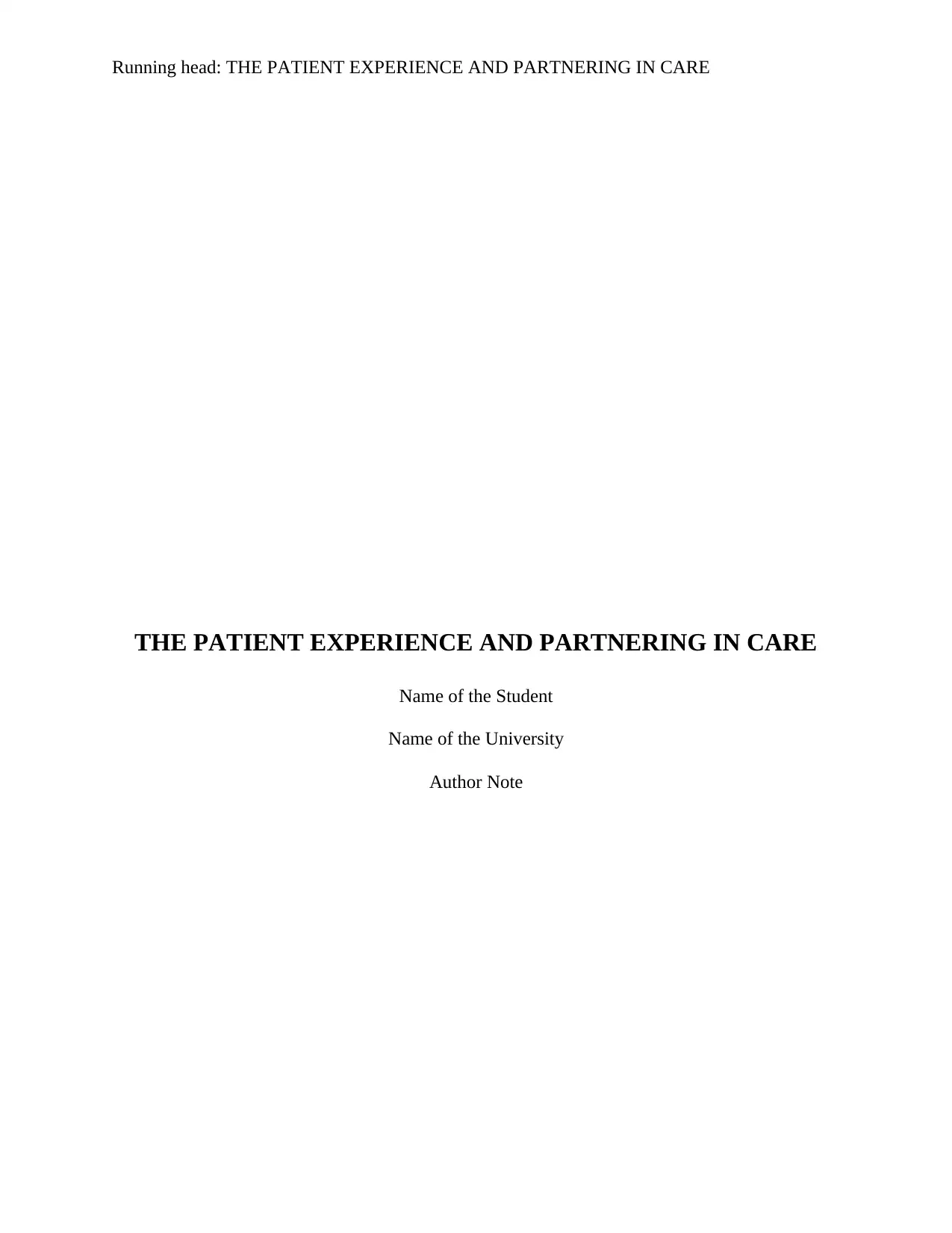
Running head: THE PATIENT EXPERIENCE AND PARTNERING IN CARE
THE PATIENT EXPERIENCE AND PARTNERING IN CARE
Name of the Student
Name of the University
Author Note
THE PATIENT EXPERIENCE AND PARTNERING IN CARE
Name of the Student
Name of the University
Author Note
Paraphrase This Document
Need a fresh take? Get an instant paraphrase of this document with our AI Paraphraser
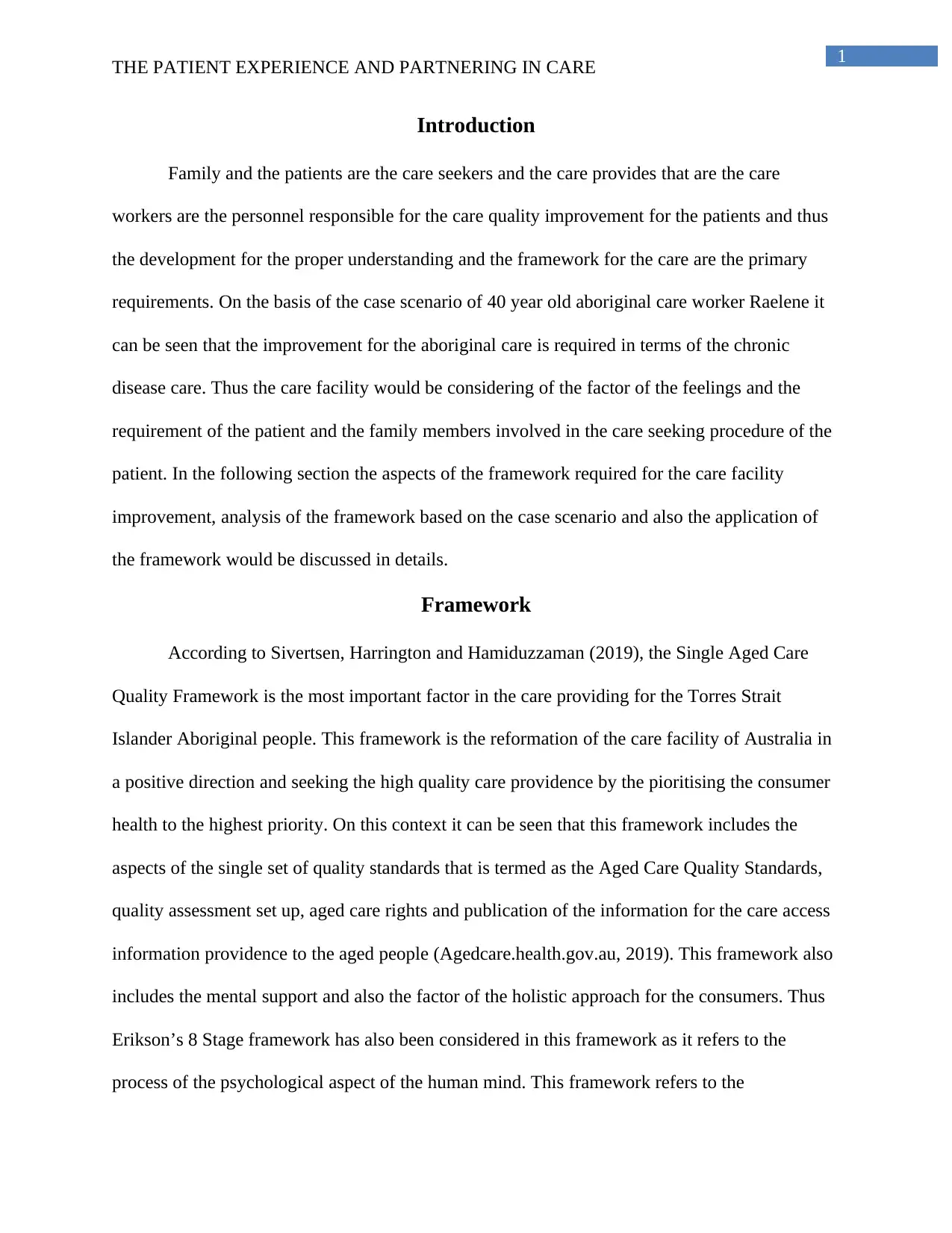
1
THE PATIENT EXPERIENCE AND PARTNERING IN CARE
Introduction
Family and the patients are the care seekers and the care provides that are the care
workers are the personnel responsible for the care quality improvement for the patients and thus
the development for the proper understanding and the framework for the care are the primary
requirements. On the basis of the case scenario of 40 year old aboriginal care worker Raelene it
can be seen that the improvement for the aboriginal care is required in terms of the chronic
disease care. Thus the care facility would be considering of the factor of the feelings and the
requirement of the patient and the family members involved in the care seeking procedure of the
patient. In the following section the aspects of the framework required for the care facility
improvement, analysis of the framework based on the case scenario and also the application of
the framework would be discussed in details.
Framework
According to Sivertsen, Harrington and Hamiduzzaman (2019), the Single Aged Care
Quality Framework is the most important factor in the care providing for the Torres Strait
Islander Aboriginal people. This framework is the reformation of the care facility of Australia in
a positive direction and seeking the high quality care providence by the pioritising the consumer
health to the highest priority. On this context it can be seen that this framework includes the
aspects of the single set of quality standards that is termed as the Aged Care Quality Standards,
quality assessment set up, aged care rights and publication of the information for the care access
information providence to the aged people (Agedcare.health.gov.au, 2019). This framework also
includes the mental support and also the factor of the holistic approach for the consumers. Thus
Erikson’s 8 Stage framework has also been considered in this framework as it refers to the
process of the psychological aspect of the human mind. This framework refers to the
THE PATIENT EXPERIENCE AND PARTNERING IN CARE
Introduction
Family and the patients are the care seekers and the care provides that are the care
workers are the personnel responsible for the care quality improvement for the patients and thus
the development for the proper understanding and the framework for the care are the primary
requirements. On the basis of the case scenario of 40 year old aboriginal care worker Raelene it
can be seen that the improvement for the aboriginal care is required in terms of the chronic
disease care. Thus the care facility would be considering of the factor of the feelings and the
requirement of the patient and the family members involved in the care seeking procedure of the
patient. In the following section the aspects of the framework required for the care facility
improvement, analysis of the framework based on the case scenario and also the application of
the framework would be discussed in details.
Framework
According to Sivertsen, Harrington and Hamiduzzaman (2019), the Single Aged Care
Quality Framework is the most important factor in the care providing for the Torres Strait
Islander Aboriginal people. This framework is the reformation of the care facility of Australia in
a positive direction and seeking the high quality care providence by the pioritising the consumer
health to the highest priority. On this context it can be seen that this framework includes the
aspects of the single set of quality standards that is termed as the Aged Care Quality Standards,
quality assessment set up, aged care rights and publication of the information for the care access
information providence to the aged people (Agedcare.health.gov.au, 2019). This framework also
includes the mental support and also the factor of the holistic approach for the consumers. Thus
Erikson’s 8 Stage framework has also been considered in this framework as it refers to the
process of the psychological aspect of the human mind. This framework refers to the
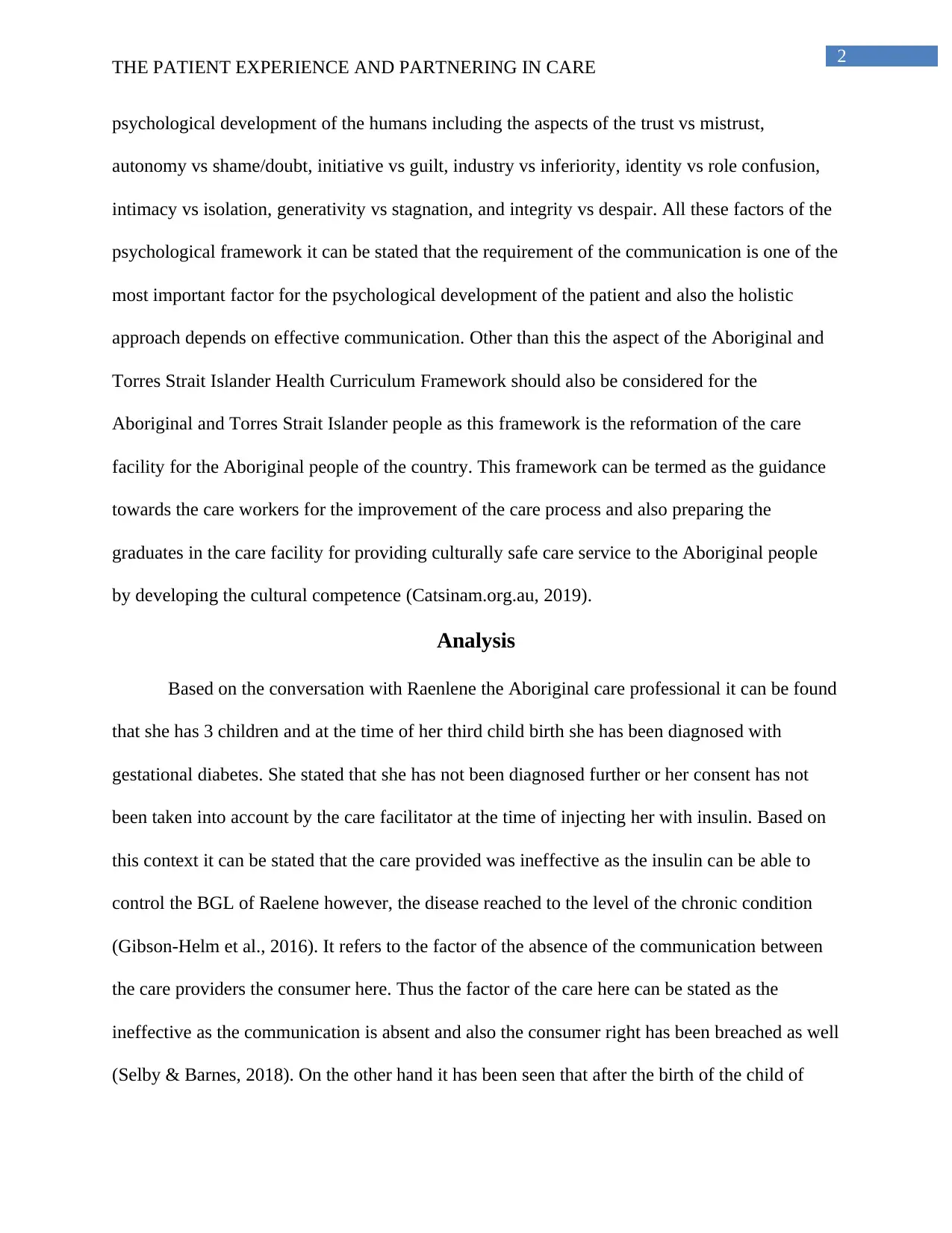
2
THE PATIENT EXPERIENCE AND PARTNERING IN CARE
psychological development of the humans including the aspects of the trust vs mistrust,
autonomy vs shame/doubt, initiative vs guilt, industry vs inferiority, identity vs role confusion,
intimacy vs isolation, generativity vs stagnation, and integrity vs despair. All these factors of the
psychological framework it can be stated that the requirement of the communication is one of the
most important factor for the psychological development of the patient and also the holistic
approach depends on effective communication. Other than this the aspect of the Aboriginal and
Torres Strait Islander Health Curriculum Framework should also be considered for the
Aboriginal and Torres Strait Islander people as this framework is the reformation of the care
facility for the Aboriginal people of the country. This framework can be termed as the guidance
towards the care workers for the improvement of the care process and also preparing the
graduates in the care facility for providing culturally safe care service to the Aboriginal people
by developing the cultural competence (Catsinam.org.au, 2019).
Analysis
Based on the conversation with Raenlene the Aboriginal care professional it can be found
that she has 3 children and at the time of her third child birth she has been diagnosed with
gestational diabetes. She stated that she has not been diagnosed further or her consent has not
been taken into account by the care facilitator at the time of injecting her with insulin. Based on
this context it can be stated that the care provided was ineffective as the insulin can be able to
control the BGL of Raelene however, the disease reached to the level of the chronic condition
(Gibson-Helm et al., 2016). It refers to the factor of the absence of the communication between
the care providers the consumer here. Thus the factor of the care here can be stated as the
ineffective as the communication is absent and also the consumer right has been breached as well
(Selby & Barnes, 2018). On the other hand it has been seen that after the birth of the child of
THE PATIENT EXPERIENCE AND PARTNERING IN CARE
psychological development of the humans including the aspects of the trust vs mistrust,
autonomy vs shame/doubt, initiative vs guilt, industry vs inferiority, identity vs role confusion,
intimacy vs isolation, generativity vs stagnation, and integrity vs despair. All these factors of the
psychological framework it can be stated that the requirement of the communication is one of the
most important factor for the psychological development of the patient and also the holistic
approach depends on effective communication. Other than this the aspect of the Aboriginal and
Torres Strait Islander Health Curriculum Framework should also be considered for the
Aboriginal and Torres Strait Islander people as this framework is the reformation of the care
facility for the Aboriginal people of the country. This framework can be termed as the guidance
towards the care workers for the improvement of the care process and also preparing the
graduates in the care facility for providing culturally safe care service to the Aboriginal people
by developing the cultural competence (Catsinam.org.au, 2019).
Analysis
Based on the conversation with Raenlene the Aboriginal care professional it can be found
that she has 3 children and at the time of her third child birth she has been diagnosed with
gestational diabetes. She stated that she has not been diagnosed further or her consent has not
been taken into account by the care facilitator at the time of injecting her with insulin. Based on
this context it can be stated that the care provided was ineffective as the insulin can be able to
control the BGL of Raelene however, the disease reached to the level of the chronic condition
(Gibson-Helm et al., 2016). It refers to the factor of the absence of the communication between
the care providers the consumer here. Thus the factor of the care here can be stated as the
ineffective as the communication is absent and also the consumer right has been breached as well
(Selby & Barnes, 2018). On the other hand it has been seen that after the birth of the child of
⊘ This is a preview!⊘
Do you want full access?
Subscribe today to unlock all pages.

Trusted by 1+ million students worldwide

3
THE PATIENT EXPERIENCE AND PARTNERING IN CARE
Raelene, her sister had died and thus the diabetes level never been controlled as her stress level
has never been checked. The conversation also highlighted that the Aboriginal care should be
considering of the aspects of the integrity of the Aboriginal people and also the aspects of the
cultural competence along with the psychological aspects (Dennis, 2019). The factor of the
health care should be considering the fact of the bonds of the Aboriginal people as the whole
community of the patient can act as the family member of the patient. On the other hand the
cultural competence and also the language understanding would also be required in the process
of the Aboriginal care. The language of the patient and also the family should be considered in
the highest priority as the culture and the language play a key role in the communication and
communication is the primary aspect of care. In this conversation Raelene also stated one
experience where one Aboriginal person has been admitted to a care facility and the conversation
of the nurses about the judgment of that person lead to the deterioration of that person’s health.
On this context it can be highlighted that the proper conversation and also elimination of any
judgmental statement about the patient would be effective health care for that person (Reeves,
2016). Based on this analysis of the conversation it can be stated that the Aboriginal care should
be focused on the mental and the cultural aspect of the consumer for the better outcome of the
patient.
Application of Framework
The aspect of the care facility for the Aboriginal people should be considering the well
being of the consumer and also the culture and health priority of the person. Hence, the patient
centered care and also the effective communication would be the aspects of providing proper
care to the patient. On the other hand the Single Aged Care Quality Framework, Erikson’s 8
Stage framework and the Aboriginal and Torres Strait Islander Health Curriculum Framework
THE PATIENT EXPERIENCE AND PARTNERING IN CARE
Raelene, her sister had died and thus the diabetes level never been controlled as her stress level
has never been checked. The conversation also highlighted that the Aboriginal care should be
considering of the aspects of the integrity of the Aboriginal people and also the aspects of the
cultural competence along with the psychological aspects (Dennis, 2019). The factor of the
health care should be considering the fact of the bonds of the Aboriginal people as the whole
community of the patient can act as the family member of the patient. On the other hand the
cultural competence and also the language understanding would also be required in the process
of the Aboriginal care. The language of the patient and also the family should be considered in
the highest priority as the culture and the language play a key role in the communication and
communication is the primary aspect of care. In this conversation Raelene also stated one
experience where one Aboriginal person has been admitted to a care facility and the conversation
of the nurses about the judgment of that person lead to the deterioration of that person’s health.
On this context it can be highlighted that the proper conversation and also elimination of any
judgmental statement about the patient would be effective health care for that person (Reeves,
2016). Based on this analysis of the conversation it can be stated that the Aboriginal care should
be focused on the mental and the cultural aspect of the consumer for the better outcome of the
patient.
Application of Framework
The aspect of the care facility for the Aboriginal people should be considering the well
being of the consumer and also the culture and health priority of the person. Hence, the patient
centered care and also the effective communication would be the aspects of providing proper
care to the patient. On the other hand the Single Aged Care Quality Framework, Erikson’s 8
Stage framework and the Aboriginal and Torres Strait Islander Health Curriculum Framework
Paraphrase This Document
Need a fresh take? Get an instant paraphrase of this document with our AI Paraphraser
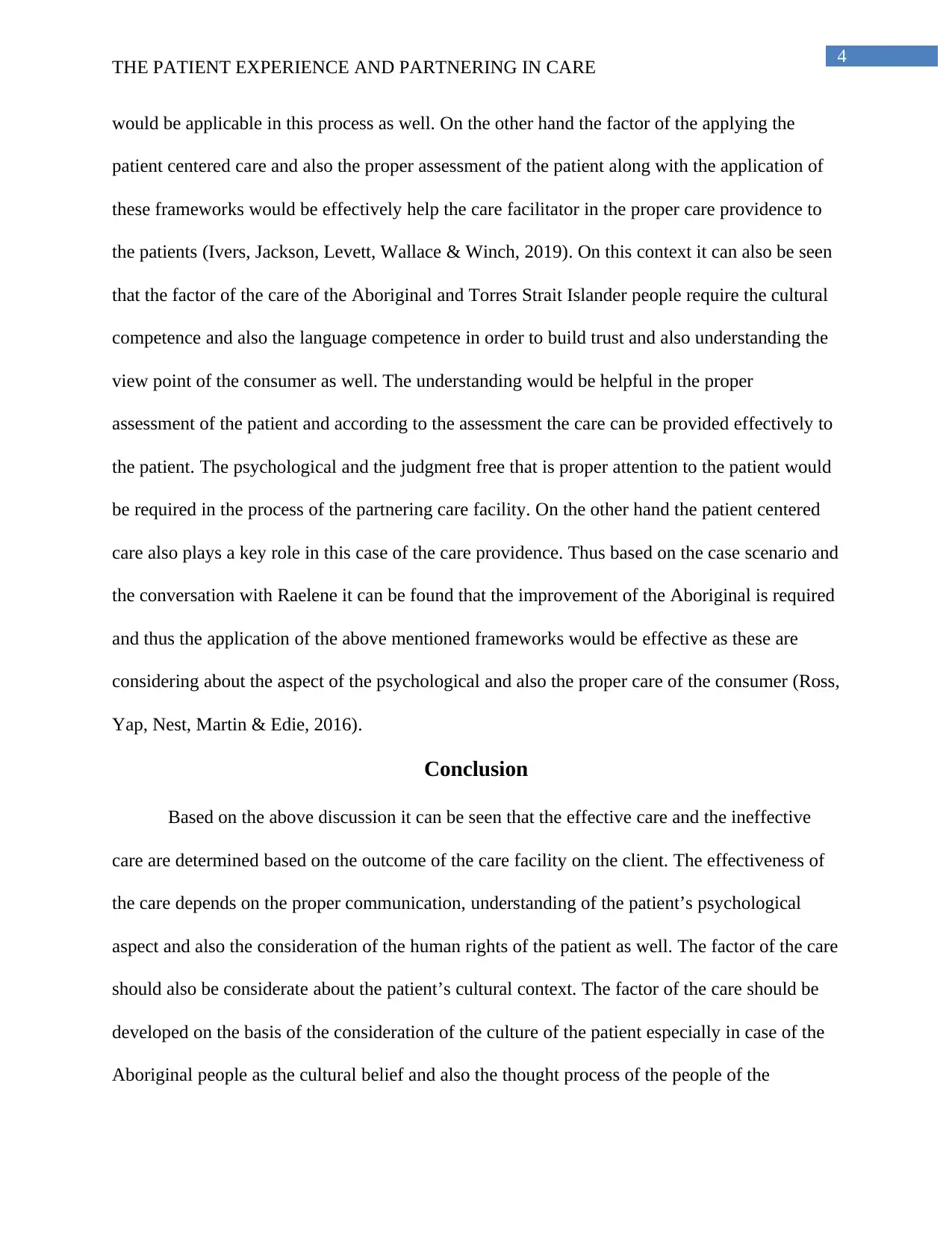
4
THE PATIENT EXPERIENCE AND PARTNERING IN CARE
would be applicable in this process as well. On the other hand the factor of the applying the
patient centered care and also the proper assessment of the patient along with the application of
these frameworks would be effectively help the care facilitator in the proper care providence to
the patients (Ivers, Jackson, Levett, Wallace & Winch, 2019). On this context it can also be seen
that the factor of the care of the Aboriginal and Torres Strait Islander people require the cultural
competence and also the language competence in order to build trust and also understanding the
view point of the consumer as well. The understanding would be helpful in the proper
assessment of the patient and according to the assessment the care can be provided effectively to
the patient. The psychological and the judgment free that is proper attention to the patient would
be required in the process of the partnering care facility. On the other hand the patient centered
care also plays a key role in this case of the care providence. Thus based on the case scenario and
the conversation with Raelene it can be found that the improvement of the Aboriginal is required
and thus the application of the above mentioned frameworks would be effective as these are
considering about the aspect of the psychological and also the proper care of the consumer (Ross,
Yap, Nest, Martin & Edie, 2016).
Conclusion
Based on the above discussion it can be seen that the effective care and the ineffective
care are determined based on the outcome of the care facility on the client. The effectiveness of
the care depends on the proper communication, understanding of the patient’s psychological
aspect and also the consideration of the human rights of the patient as well. The factor of the care
should also be considerate about the patient’s cultural context. The factor of the care should be
developed on the basis of the consideration of the culture of the patient especially in case of the
Aboriginal people as the cultural belief and also the thought process of the people of the
THE PATIENT EXPERIENCE AND PARTNERING IN CARE
would be applicable in this process as well. On the other hand the factor of the applying the
patient centered care and also the proper assessment of the patient along with the application of
these frameworks would be effectively help the care facilitator in the proper care providence to
the patients (Ivers, Jackson, Levett, Wallace & Winch, 2019). On this context it can also be seen
that the factor of the care of the Aboriginal and Torres Strait Islander people require the cultural
competence and also the language competence in order to build trust and also understanding the
view point of the consumer as well. The understanding would be helpful in the proper
assessment of the patient and according to the assessment the care can be provided effectively to
the patient. The psychological and the judgment free that is proper attention to the patient would
be required in the process of the partnering care facility. On the other hand the patient centered
care also plays a key role in this case of the care providence. Thus based on the case scenario and
the conversation with Raelene it can be found that the improvement of the Aboriginal is required
and thus the application of the above mentioned frameworks would be effective as these are
considering about the aspect of the psychological and also the proper care of the consumer (Ross,
Yap, Nest, Martin & Edie, 2016).
Conclusion
Based on the above discussion it can be seen that the effective care and the ineffective
care are determined based on the outcome of the care facility on the client. The effectiveness of
the care depends on the proper communication, understanding of the patient’s psychological
aspect and also the consideration of the human rights of the patient as well. The factor of the care
should also be considerate about the patient’s cultural context. The factor of the care should be
developed on the basis of the consideration of the culture of the patient especially in case of the
Aboriginal people as the cultural belief and also the thought process of the people of the

5
THE PATIENT EXPERIENCE AND PARTNERING IN CARE
community should be considered as well in order to provide a safe and positive care to the
patient.
THE PATIENT EXPERIENCE AND PARTNERING IN CARE
community should be considered as well in order to provide a safe and positive care to the
patient.
⊘ This is a preview!⊘
Do you want full access?
Subscribe today to unlock all pages.

Trusted by 1+ million students worldwide
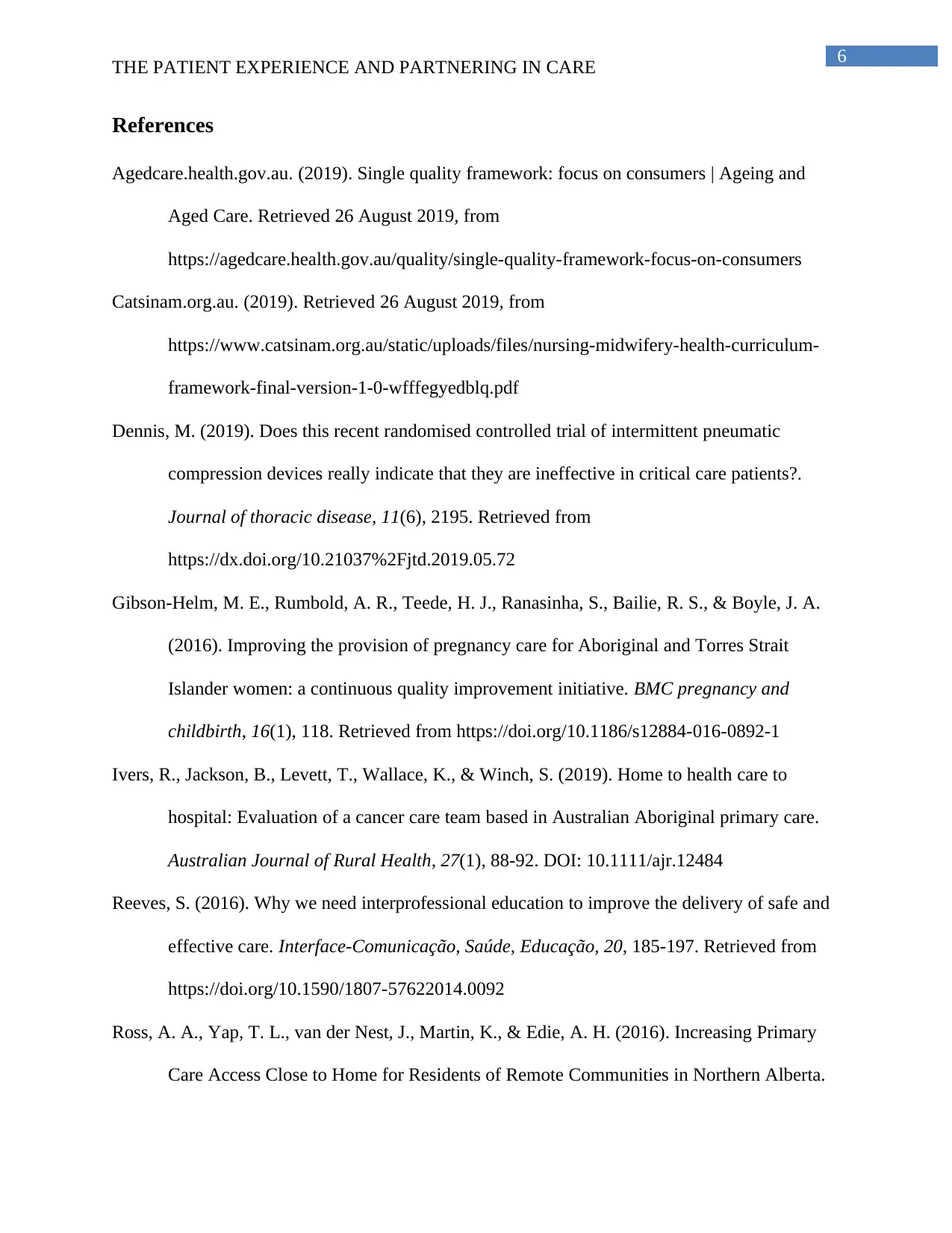
6
THE PATIENT EXPERIENCE AND PARTNERING IN CARE
References
Agedcare.health.gov.au. (2019). Single quality framework: focus on consumers | Ageing and
Aged Care. Retrieved 26 August 2019, from
https://agedcare.health.gov.au/quality/single-quality-framework-focus-on-consumers
Catsinam.org.au. (2019). Retrieved 26 August 2019, from
https://www.catsinam.org.au/static/uploads/files/nursing-midwifery-health-curriculum-
framework-final-version-1-0-wfffegyedblq.pdf
Dennis, M. (2019). Does this recent randomised controlled trial of intermittent pneumatic
compression devices really indicate that they are ineffective in critical care patients?.
Journal of thoracic disease, 11(6), 2195. Retrieved from
https://dx.doi.org/10.21037%2Fjtd.2019.05.72
Gibson-Helm, M. E., Rumbold, A. R., Teede, H. J., Ranasinha, S., Bailie, R. S., & Boyle, J. A.
(2016). Improving the provision of pregnancy care for Aboriginal and Torres Strait
Islander women: a continuous quality improvement initiative. BMC pregnancy and
childbirth, 16(1), 118. Retrieved from https://doi.org/10.1186/s12884-016-0892-1
Ivers, R., Jackson, B., Levett, T., Wallace, K., & Winch, S. (2019). Home to health care to
hospital: Evaluation of a cancer care team based in Australian Aboriginal primary care.
Australian Journal of Rural Health, 27(1), 88-92. DOI: 10.1111/ajr.12484
Reeves, S. (2016). Why we need interprofessional education to improve the delivery of safe and
effective care. Interface-Comunicação, Saúde, Educação, 20, 185-197. Retrieved from
https://doi.org/10.1590/1807-57622014.0092
Ross, A. A., Yap, T. L., van der Nest, J., Martin, K., & Edie, A. H. (2016). Increasing Primary
Care Access Close to Home for Residents of Remote Communities in Northern Alberta.
THE PATIENT EXPERIENCE AND PARTNERING IN CARE
References
Agedcare.health.gov.au. (2019). Single quality framework: focus on consumers | Ageing and
Aged Care. Retrieved 26 August 2019, from
https://agedcare.health.gov.au/quality/single-quality-framework-focus-on-consumers
Catsinam.org.au. (2019). Retrieved 26 August 2019, from
https://www.catsinam.org.au/static/uploads/files/nursing-midwifery-health-curriculum-
framework-final-version-1-0-wfffegyedblq.pdf
Dennis, M. (2019). Does this recent randomised controlled trial of intermittent pneumatic
compression devices really indicate that they are ineffective in critical care patients?.
Journal of thoracic disease, 11(6), 2195. Retrieved from
https://dx.doi.org/10.21037%2Fjtd.2019.05.72
Gibson-Helm, M. E., Rumbold, A. R., Teede, H. J., Ranasinha, S., Bailie, R. S., & Boyle, J. A.
(2016). Improving the provision of pregnancy care for Aboriginal and Torres Strait
Islander women: a continuous quality improvement initiative. BMC pregnancy and
childbirth, 16(1), 118. Retrieved from https://doi.org/10.1186/s12884-016-0892-1
Ivers, R., Jackson, B., Levett, T., Wallace, K., & Winch, S. (2019). Home to health care to
hospital: Evaluation of a cancer care team based in Australian Aboriginal primary care.
Australian Journal of Rural Health, 27(1), 88-92. DOI: 10.1111/ajr.12484
Reeves, S. (2016). Why we need interprofessional education to improve the delivery of safe and
effective care. Interface-Comunicação, Saúde, Educação, 20, 185-197. Retrieved from
https://doi.org/10.1590/1807-57622014.0092
Ross, A. A., Yap, T. L., van der Nest, J., Martin, K., & Edie, A. H. (2016). Increasing Primary
Care Access Close to Home for Residents of Remote Communities in Northern Alberta.
Paraphrase This Document
Need a fresh take? Get an instant paraphrase of this document with our AI Paraphraser

7
THE PATIENT EXPERIENCE AND PARTNERING IN CARE
Healthcare quarterly (Toronto, Ont.), 19(3), 61-66. Retrieved from
https://pdfs.semanticscholar.org/e81b/34831ece57961b9917f6aea71acc76f115ed.pdf
Selby, K., & Barnes, G. D. (2018). Learning to de-adopt ineffective healthcare practices. The
American journal of medicine, 131(7), 721-722.
Sivertsen, N., Harrington, A., & Hamiduzzaman, M. (2019). Exploring Aboriginal aged care
residents’ cultural and spiritual needs in South Australia. BMC Health Services
Research, 19(1). doi:10.1186/s12913-019-4322-8
THE PATIENT EXPERIENCE AND PARTNERING IN CARE
Healthcare quarterly (Toronto, Ont.), 19(3), 61-66. Retrieved from
https://pdfs.semanticscholar.org/e81b/34831ece57961b9917f6aea71acc76f115ed.pdf
Selby, K., & Barnes, G. D. (2018). Learning to de-adopt ineffective healthcare practices. The
American journal of medicine, 131(7), 721-722.
Sivertsen, N., Harrington, A., & Hamiduzzaman, M. (2019). Exploring Aboriginal aged care
residents’ cultural and spiritual needs in South Australia. BMC Health Services
Research, 19(1). doi:10.1186/s12913-019-4322-8
1 out of 8
Related Documents
Your All-in-One AI-Powered Toolkit for Academic Success.
+13062052269
info@desklib.com
Available 24*7 on WhatsApp / Email
![[object Object]](/_next/static/media/star-bottom.7253800d.svg)
Unlock your academic potential
Copyright © 2020–2025 A2Z Services. All Rights Reserved. Developed and managed by ZUCOL.





